
Choose your specialty from the list below to see how our experts have tackled a wide range of client questions.
Looking for something specific? Utilize our search feature by typing in a key word!
Replacement Code for “Interbody Cage for Disc”
I see that CPT code 22851 – Application of intervertebral biomechanical device(s) to vertebral defect or interspace was deleted in 2017. What code do I use in 2017 for placement of
Question:
I see that CPT code 22851 – Application of intervertebral biomechanical device(s) to vertebral defect or interspace was deleted in 2017. What code do I use in 2017 for placement of an interbody cage for disc that does not have integral fixation and is being used for fusion? I see the new codes 22853 and 22854 both say with integral anterior instrumentation device for anchoring.
Answer:
Three codes have been added to CPT 2017:
- 22853 is used for interbody device insertion, with fusion, with or without integrated anterior fixation
- 22854 is used for interbody device insertion for corpectomy, with fusion, with or without integrated anterior fixation
- 22859 is used for interbody device insertion without fusion
Your options will be 22853 or 22854, depending on whether performing corpectomy. 22853 and 22854 both say “with integral anterior instrumentation for device anchoring when performed.”If you do not use integrated fixation, it is still the same codes. If you use a separate plate, that would be reportable when specific criteria are met (e.g. the plate crosses the interspace, can provide independent stabilization, and can be used with any other type of interspace device.)
*This response is based on the best information available as of 01/05/17.
Acromioclavicular Joint Billing
When our physician performs an injection into the acromioclavicular (AC) joint of a patient in the office, can we bill 20610 for a large joint arthrocentesis? I say yes because it is…
Question:
When our physician performs an injection into the acromioclavicular (AC) joint of a patient in the office, can we bill 20610 for a large joint arthrocentesis? I say yes because it is in the shoulder, which is listed as an example large joint in the code descriptor.
Answer:
No. The correct code to bill in this case would be 20605 for an intermediate joint. Although the AC joint is between the shoulder and the clavicle, it is considered an intermediate joint. If you look at the example intermediate joints in the descriptor for 20605 they include: temporomandibular, acromioclavicular, wrist, elbow or ankle, or olecranon bursa. The example large joints listed for code 20610 include: shoulder, hip, knee, subacromial bursa. If the physician performs the AC injection utilizing ultrasound guidance with permanent recording and reporting, then you should report code 20606 instead of 20605. And don’t forget to bill the HCPCS II code for the medication itself.
*This response is based on the best information available as of 10/27/16.
Reimbursement: Assistant Surgeon
What is the reimbursement for an assistant surgeon using modifier 80? Is the payment different for the primary and the assistant? What about a PA or nurse practitioner who assists at…
Question:
What is the reimbursement for an assistant surgeon using modifier 80? Is the payment different for the primary and the assistant? What about a PA or nurse practitioner who assists at surgery?
Answer:
An assistant surgeon is described as one surgeon, of the same or a different specialty, providing assistance during a surgical procedure or CPT code.
Modifier 80 (modifier 82 for an assistant surgeon in an academic setting when a qualified resident is not available) is appended to any CPT code the assistant participates in. Medicare reimburses 16% of the allowable for the assistant surgeon (modifier 80 or 82) and multiple procedure/bilateral procedure reductions also apply. The primary surgeon’s reimbursement is not affected. In an assistant surgeon scenario, the assistant need not and should not dictate a separate note. However, it is critical that the primary surgeon document in his/her note, specifically what the assistant did. Stating an assistant was needed because the case was complex is not sufficient. The primary surgeon must state what the assistant did, for example, assisting with positioning and retraction, surgical closure, etc. When a physician assistant or nurse practitioner assists in surgery, Medicare reduces their reimbursement by 15% of what a physician would be paid for assisting, and Medicare directs us to designate a PA or NP service using modifier AS (instead of modifier 80).
Keep in mind, Medicare does not allow payment for assistant support for all surgical CPT codes. For private payers, coding guidelines and payment rates may vary.
*This response is based on the best information available as of 09/29/16.
ICD 10: Aftercare Z Codes or 7th Character Code?
Patient has been seen in office during the global period after a rotator cuff repair for a sprain. No X-rays were taken. Internally we…
UPDATED
Question:
Patient has been seen in office during the global period after a rotator cuff repair for a sprain. No X-rays were taken. Internally we will record 99024. Would we assign Z47.89 or the sprain code to 99024?
Answer:
Thanks for your inquiry as your question gives us an opportunity to address documentation requirements and how sprains and strains are delineated in ICD-10-CM.
First, under ICD-10-CM descriptions, an acute injury to the rotator cuff muscle or tendon is described as a “strain”, under the subcategory S46,01- , not as a “sprain.” Although there is also an ICD code for sprain of the rotator cuff capsule, S43.42-, that is not the structure that typically injured.
If you’ve determined that the problem is an injury, you will look to the S codes; if it is a chronic or recurrent problem, you will look to the M codes.
The ICD-10-CM options for a rotator cuff strain are:S46.011- Strain of muscle(s) and tendon(s) of the rotator cuff of right shoulderS46.012- Strain of muscle(s) and tendon(s) of the rotator cuff of left shoulderS46.019- Strain of muscle(s) and tendon(s) of the rotator cuff of unspecified shoulder
Ideally the physician will document whether the strain affects the right or left shoulder; use of the unspecified code is reserved for cases when the laterality is not described.
If the patient is seen in the global period for the injury, then the 7th character D is applied to indicate routine healing following active treatment of an injury.
If the surgery was done to treat a chronic or degenerative condition coded from the M chapter, you will report Z47.89, Encounter for other orthopedic aftercare, provided the follow-up is uncomplicated.
*This response is based on the best information available as of 02/4/16.
Lysis of Adhesions In the Shoulder
We are having a debate in our office we hope you can help unravel. We want to report CPT code 29827 and 29825 together but our Coding Companion states that they are inclusive to each…
Question:
We are having a debate in our office we hope you can help unravel. We want to report CPT code 29827 and 29825 together but our Coding Companion states that they are inclusive to each other and are bundled. Our surgeon is Question:ing the accuracy of this information.
Answer:
Your surgeon is correct to question this information. CPT code 29825 describes arthroscopic lysis of adhesions; CPT code 29827 describes an arthroscopic rotator cuff repair. According to the AAOS Global Service Data Guide, these two procedures are exclusive to each other. Each procedure is supported by the medical necessity of two separate conditions and have separately identifiable diagnosis codes. If your Coding Companion is based on Medicare payment rules, you will see the two services as bundled together. This is where it is important to understand the differences between CPT coding rules and Medicare payment rules.
For Medicare Part B carriers, you would not report the two codes together as there is an NCCI edit in place; CMS considers shoulders procedures on the ipsilateral procedure inclusive to each other when an edit exists thus, a modifier may not be applied (e.g. 59, XU) to the code combination. In your scenario, only the rotator cuff repair is reportable to Medicare Part B (remember, NCCI edits are for Medicare Part B and may apply to Medicaid also).
For private payors who follow CPT rules, the code combination is reportable together and represents correct coding.
*This response is based on the best information available as of 01/14/16.
Are Cast Re-Applications Included in the Global Period?
We are hospital employed and are being told that we cannot bill for cast re-applications in the global period. An article posted in the AAOS coding column tells us that cast re-applications…
Question:
We are hospital employed and are being told that we cannot bill for cast re-applications in the global period. An article posted in the AAOS coding column tells us that cast re-applications are separately reportable and to append a modifier 58. We also understand that modifier 58 restarts the global period. In my old job, I was told by a billing company that post-op casting was included in the global period and was not payable unless there was a complication with the cast. Is a cast re-application billable in the global period when medically necessary and will the global period re-start?
Answer:
Thanks for your inquiry. For some readers this will be a very mundane Question:, but we are hearing this question more and more frequently so this is a good time to re-address how to report the services and why the services are reportable.
Let’s answer the first question first. Are cast re-applications billing during the global period? Yes! The first cast is inclusive to the global surgical CPT code, but re-applications are billable, assuming of course, that medical necessity is present. The following is the CPT citation: The very first sentence in the Application of Casts and Strapping section of CPT states, “The listed procedures apply when thecast application or strapping is a replacement procedure used during or after the period of follow-up care, or when the cast application or strapping is an initial service performed without a restorative treatment or procedure(s) to stabilize or protect a fracture, injury, or dislocation and/or to afford comfort to a patient.”
The answer to the second question is no, the global period will not re-start because splints and cast CPT codes have zero global days; as such, the global days cannot be reset or re-started.
*This response is based on the best information available as of 12/17/15.

